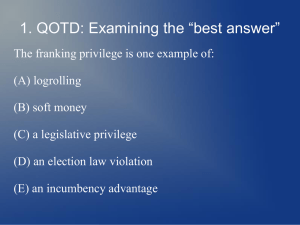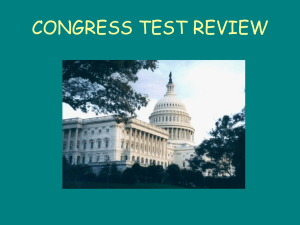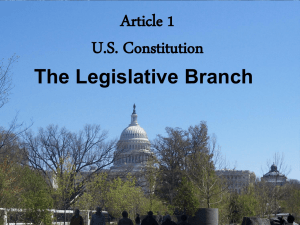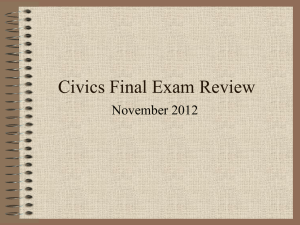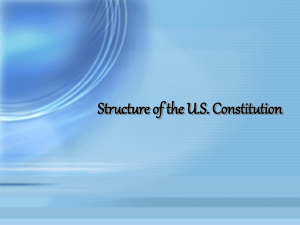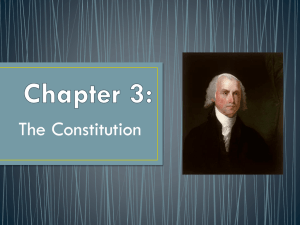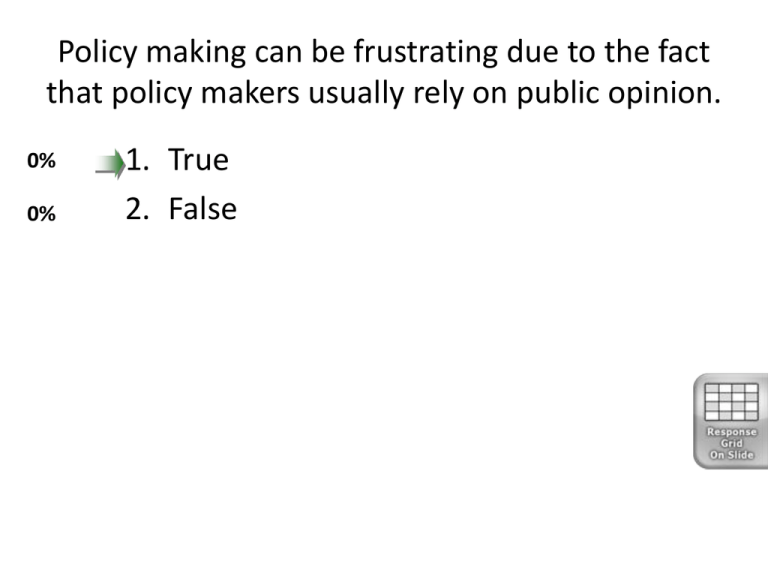
Policy making can be frustrating due to the fact
that policy makers usually rely on public opinion.
0%
0%
1. True
2. False
This requires policy makers move quickly when
making policy, before public gets bored and
loses interest.
1. Incrementalism
2. Policy fragmentation
3. Agenda setting
4. Issue-attention cycle
5. Policy formulation
ul
a
t io
n
0%
fo
rm
icy
Po
l
tte
nt
io
n
se
t
nd
a
0%
cy
c le
tin
n
tio
Ag
e
en
ta
m
0%
g
0%
Iss
ue
-a
Po
l
icy
In
cr
fra
g
em
en
ta
l
ism
0%
Incrementalism is a fast moving process in
which policy makers work to rush out a
solution to a problem.
0%
0%
1. True
2. False
With regards to defining the role of government,
the political left favors more government
activity.
1. True
2. False
se
0%
Fa
l
Tr
ue
0%
With regards to agenda setting, everyone has
equal input when it comes to developing policy.
0%
0%
1. True
2. False
The war on drugs is an example of a policy
that has been heavily fragmented.
1. True
2. False
se
0%
Fa
l
Tr
ue
0%
The Constitution as ratified in 1788 most
clearly reflects the framers’ commitment
to
1.
2.
3.
4.
in
g
.
0%
ac
y.
th
e
pr
im
ft
he
ts
o
ta
in
ct
in
gr
igh
on
lit
i
Pr
ot
e
Ab
o
0%
...
ve
ry
of
sla
rn
m
go
ve
d
it e
Lim
0%
M
ain
cy
oc
ra
de
m
0%
en
t
0%
Di
re
ct
Direct democracy
Limited government
Abolition of slavery
Protecting rights of
the accused
5. Maintaining the
primacy of the
states
Which of the following most accurately
describes The Federalist Papers?
0%
0%
0%
0%
0%
1. The Federalist party platform during the
presidency of John Adams, the first Federalist
President.
2. A popular anti-British booklet of the
Revolutionary era
3. A collection of essays arguing the merits of the
Constitution
4. A series of congressional acts defining the
relationship between the federal and state
governments.
5. The laws under which the South was governed
during Reconstruction
All of the following are specifically
mentioned in the Constitution EXCEPT
0%
0%
ad
dr
te
es
rm
s
of
fe
de
ra
.. .
on
of
th
Le
ng
St
a
te
of
th
e
Un
i
fi
m
pe
ac
hm
en
su
s
lc
io
na
0%
en
t
0%
Ru
le
so
Na
t
al
re
vie
w
0%
Ju
di
ci
1. Judicial review
2. National census
3. Rules of
impeachment
4. State of the Union
address
5. Length of term of
federal judgeships
Which of the following best illustrates
the best use of the elastic clause?
0%
0%
0%
0%
0%
1. The Supreme Court allows a lower court ruling to
stand by refusing to hear an appeal.
2. A congressional committee prevents the full
chamber from voting on legislation by delaying
its report.
3. Congress passes legislation establishing a
national speed limit.
4. A member of the House of Reps introduces a bill
to increase federal income tax
5. A governor issues an executive order requiring all
state employees to submit to drug testing
The swift adoption of the Bill of Rights in the
years following the ratification of the
Constitution demonstrates the
0%
0%
0%
0%
0%
1. Framers ‘ unqualified commitment to
individual rights
2. Small states’ determination to receive equal
representation in the legislature
3. Northern states’ support for abolitionism
4. States’ fears of a overpowerful national
government
5. Federalists’ concerns that the system of
checks and balances would weaken the
national government
According to the Federalist Papers, federalism
has which of the following effects on political
factions?
.
ts
fa.
.
...
ve
n
tes
It p
re
lim
ina
It e
llo
w
sf
ac
t...
...
the
5.
0% 0% 0% 0% 0%
It a
4.
a.
..
3.
It l
im
it s
2.
It provides a structured environment
in which factions may flourish.
It limits the dangers of factionalism
by diluting political power.
It allows factions to dominate on the
national level while limiting their
influence on state governments.
It eliminates any opportunity for
factions to form.
It prevents factions by declaring
them illegal.
It p
ro
vi d
es
1.
0%
0%
0%
0%
0%
The Constitution, as originally ratified,
addressed all of the following weaknesses of the
Articles of Confederation EXCEPT
1. Lack of a chief executive office.
2. National government’s inability to levy taxes
effectively.
3. Absence of a central authority to regulate
trade.
4. Insufficiency of the government’s power to
raise an army.
5. Omission of a universal woman’s suffrage
clause.
Congress would be required to use the
“elastic clause” of the Constitution to
0%
w
ar
0%
la
re
ec
ut
ho
D
riz
e
ta
x
th
e
...
r..
.
0%
se
cr
ea
In
se
w
or
kp
la
.
..
en
.
tiz
ci
Im
po
ng
e
ha
C
0%
..
0%
A
1. Change citizenship
requirements
2. Impose workplace
safety standards
3. Increase tax rates
4. Authorize the treasury
to print money
5. Declare war
The framers of the Constitution sought to
insulate the Senate from public opinion by
0%
0%
0%
0%
0%
1. Restricting Senate membership to those who
previously served in the House of
Representatives.
2. Delegating the responsibility for electing
senators to the state legislatures.
3. Requiring all spending bills to originate in the
House of Reps.
4. Empowering the Senate to provide advice and
consent to the executive branch.
5. Assigning exactly two senators to each state’s
congressional delegation.
Under the Articles of Confederation, the
national government had the power to
te
r..
.
...
0%
la
eg
ul
a
te
in
its
fo
rc
e
a
En
h
ta
b
0%
R
es
ct
ta
x
ol
le
C
0%
fe
...
0%
Es
N
eg
ot
ia
te
tre
a
...
0%
lis
1. Negotiate treaties
2. Collect taxes
3. Establish a federal
judiciary
4. Enforce its laws
5. Regulate interstate
commerce
In Federalist 10, James Madison argues that a federal
system of govt. reduces the danger of political factions
by
0%
0%
0%
0%
0%
1. Creating insurmountable obstacles to
the creation of factions
2. Making it difficult for one faction to
gain the power necessary to govern
3. Requiring equal representation of all
factions within the government
4. Restricting factional political activity to
the state level only
5. Allowing federal agencies to strictly
regulate the activities of factions
Federalism
Of the following, American federalism
is greatly exemplified by the
po
t’s
id
en
Pr
es
en
d
0%
...
t..
.
0%
m
en
ti.
.
Am
th
10
Sp
ec
s
ia
l
by
co
ns
hi
..
w
ec
es
0%
.
0%
.
...
0%
ch
5.
Pr
oc
4.
of
3.
st
em
2.
System of checks and balances
among the three branches.
Process by which international
treaties are completed
Special constitutional status of
Washington, D.C.
10th Amendment, reserving
powers for the states
President’s power to grant
reprieves and pardons
Sy
1.
Which of the following correctly states the relationship
between the federal and state judiciaries?
5.
l co
urt
sa
e tw
re h
oa
i ...
re
Th
ent
e tw
irel
oa
y ..
re
Sta
.
gen
te c
era
our
l
l
y.. .
ts a
Sta
te c
re
tri a
our
l . ..
ts t
ry a
ll c
a.. .
4.
0% 0% 0% 0% 0%
Th
3.
era
2.
Federal courts are higher courts than state
courts and may overturn state decisions on any
grounds.
The two are entirely autonomous, and neither
ever hear cases that originate in the other.
The two are generally autonomous, although
federal courts may rule on the constitutionality
of state court decisions.
State courts are trial courts; federal courts are
appeals courts.
State courts try all cases except those that
involve conflicts between two states, which are
tried in federal courts
F ed
1.
To which characteristic of American government
does the term “federalism” refer?
0%
0%
0%
0%
0%
1. The system of checks and balances within the
national government.
2. The power of the Supreme Court to review the
constitutionality of laws.
3. The Bill of Rights’ protection of the rights of the
accused.
4. The process by which the size of each state’s
delegation to the House of Representatives.
5. The division and sharing of powers between the
national and state governments.
National and state governments share
all of the following powers EXCEPT
0%
0%
0%
0%
0%
1.
2.
3.
4.
5.
Administer elections
Impose taxes
Establish courts
Borrow money
Enact laws
The 10th Amendment most often comes into
conflict with which section of the Constitution?
0%
Pr
ov
is
i
on
s
fo
r..
.
st
...
0%
tin
g
ib
i
on
s
is
i
Pr
oh
y.
..
sa
r
Pr
ov
ec
“n
e
0%
fo
r..
.
0%
es
ul
l
fa
it.
..
0%
Th
5.
“f
3.
4.
e
2.
The “full faith and credit”
clause
The “necessary and proper”
clause
Provisions for impeachment
Prohibiting states from coining
money and entering treaties
Provisions for constitutional
amendments
Th
1.
People who interpret the 10th Amendment as greatly
restricting the powers of the national government are
...
ig
ht
e
es
’r
co
e
os
0%
St
at
ire
zfa
0%
ns
tr
uc
.
...
0%
Lo
La
ol
at
io
ni
ts
Is
ra
lis
de
Fe
0%
st
s
0%
is
se
1. Federalists
2. Isolationists
3. Laissez-faire
capitalists
4. Loose
constructionists
5. States’ righters
..
often referred to as
In the majority of cases, federal
programs are implemented by
0%
1. Private businesses, working as subcontractors to the
government.
2. State and local governments, by means of federal
funding.
0%
3. Congress, through the local offices of its elected
0%
officials
4. The federal courts, by means of criminal
0%
prosecutions.
0% 5. Federal agencies, through their many local offices in
cities and towns.
The government often finds it difficult to
make substantive changes to entitlement
for which of the following reasons?
0%
0%
0%
0%
0%
1. Most programs were established by
constitutional amendment.
2. These programs are extremely popular
among their numerous beneficiaries, and
the beneficiaries rely on those benefits.
3. Such programs are vital to national defense.
4. Most such programs primarily benefit the
wealthy, a powerful political bloc.
5. These programs’ budget are determined by
nonelected bureaucrats, not by the
Congress.
Judges have ordered Massachusetts to change the way
it hires firefighters, even though the state does not
receive aid from the federal government. Such an order
is referred to as a
1.
2.
3.
4.
r
m
Pe
r
cu
ria
m
re
0%
or
de
en
t
te
Pr
o
bo
no
re
o
pr
Qu
id
0%
qu
i
or
qu
o
0%
an
da
ai
of
n
tio
Co
nd
i
0%
de
r
d
0%
M
Condition of aid
Quid pro quo order
Mandate
Pro bono
requirement
5. Per curiam order
The difference between a mandate
and a condition of aid is
0%
0%
0%
0%
0%
1. With a mandate the federal government tells a
state government what it must do if it wants the
money.
2. A mandate applies to a block grant; a condition
of aid applies to a categorical grant.
3. A mandate applies to a categorical grant; a
condition of aid applies to a block grant.
4. With a mandate the federal government allows
the state to do as it pleases if its actions are in
accordance with state law.
5. With a mandate it makes no difference who is
paying the costs of a program.
The McCulloch v. Maryland
decision established
lit
y
Le
ga
ab
ov
de
Al
l
of
t
he
ve
sla
0%
e
0%
tra
a.
.
.s
ov
t
lg
io
na
Na
t
0%
em
up
r
in
in
gn
ty
so
ve
re
i
te
St
a
te
.
S..
.
th
e
by
w
vie
re
al
Ju
di
ci
0%
..
0%
of
th
e
1. Judicial review by the
Supreme Court
2. State sovereignty in
interstate commerce
3. National govt.
supremacy over the
states
4. Legality of the slave
trade
5. All of the above
Political Opinion, participation,
culture, parties
Which of the following best describes the
practice of “ticket splitting”?
0%
0%
0%
0%
0%
1. A presidential nominee selects a running mate who
can appeal to voter groups whose support of the
nominee is weak.
2. A voter chooses the presidential nominee of one
major party, but chooses congressional nominees of
the other major party.
3. A mayor orders the local police force to hand out
fewer parking violations in the weeks leading up to
the general election.
4. A delegate to a national party convention supports
the front-runner but remains uncommitted on the
party platform.
5. A member of Congress votes against legislation
proposed by his or her party leader.
Compared with political parties in countries
such as England and Israel, both of which have
multiparty systems, American political parties
are
0%
0%
0%
0%
0%
1. Less interested in influencing the outcome
of elections.
2. Less clearly identified with consistent
political ideologies.
3. Less effective at raising money from political
supporters.
4. Better able to reflect the goals of their
entire constituencies.
5. More likely to organize around a single issue
or goal
Of the following groups that have traditionally
supported the Democratic Party, which would
LEAST likely be cited by someone arguing that
the Democrats represented only liberal
constituencies?
0%
0%
0%
0%
0%
1.
2.
3.
4.
5.
White Southerners
Labor union members
African Americans
Northern ethnic minorities
environmentalists
A member of which of the following
demographic groups is most likely to
support a Republican presidential
candidate?
0%
0%
0%
0%
0%
1.
2.
3.
4.
White male
White female
African American, male or female
Youths under the age of 25, male or
female
5. Individuals earning below poverty-level
wages, male or female
Which of following is the most accurate statement
about the voting behavior of Americans over the age of
65?
0%
0%
0%
0%
0%
1. More likely, because they have higher
education.
2. More likely, because they feel as if they have a
personal stake in govt. policy.
3. Less likely, because it is difficult to get to the
polls.
4. Less likely, because less aware of election
schedules.
5. Less likely, very few senior citizens run for
political office.
The greatest number of American
voters identify themselves as
Liberal
Conservative
Progressive
Reactionary
Moderate
od
er
at
M
ea
R
0%
e
0%
ct
io
n
si
ve
re
s
se
r
on
C
Pr
og
va
t
be
r
0%
ar
y
0%
iv
e
al
0%
Li
1.
2.
3.
4.
5.
Which of the following most accurately describes the
fate of most third-party movements?
0%
0%
0%
0%
0%
1. They displace one of the two major
parties and become a major party.
2. They are ultimately abandoned by public
because their policies are too radical.
3. Their supporters become frustrated and
withdraw from the political process.
4. They remain active participants in the
American political system.
5. They disintegrate when one or both
major parties adopt third party goals.
Which of the following is an accurate statement
about the leadership of the two major political
parties?
0%
1.
2.
0%
3.
0%
0%
0%
4.
5.
The national party organization controls all facets of
party activity.
Party leadership is dispersed among numerous officials
at the national, state, and local levels.
The highest elected official in each national party
directs that party’s activists all the way down to the
state and local level.
All major decisions concerning party activities are made
during each party’s presidential nominating
conventions.
Prominent former officeholders, such a ex-presidents,
lead their respective parties.
The absence of a political party solely dedicated
to labor and working class issues in the United
States
sul
t ...
fl ec
ts t
he
De
d. ..
mo
n st
rate
s t.
I ll u
..
st ra
tes
t h. .
.
. po
. ..
0% 0% 0% 0% 0%
Re
he
re
5.
U.S
4.
Is t
3.
ves
2.
Proves U.S. politicians are not concerned about
serving working-class constituencies
Is the result of government restrictions placed on
labor unions
Reflects the difficulty of unifying a party around a
single issue in a “winner take all” format
Demonstrates that, in the United States, most
political issues regarding workers have been decided
in the workers’ favor
Illustrates that race, not class, is the primary political
division in the United States.
Pro
1.
Which of the following is true of most
third parties in U.S. history?
0%
...
...
0%
Th
ey
flo
ar
os
e
ur
is
in
he
t.
ey
Th
A
ts
w
om
e
er
e
po
in
cr
ea
d.
..
an
ey
0%
..
0%
...
0%
e
5.
Th
4.
ar
os
3.
ey
2.
They arose and succeeded
during times of prosperity
They were created to protest
wars
At some point they won a
majority of seats in Congress
They flourished during times of
widespread dissatisfaction
They arose in response to
increased government
regulation
Th
1.
An open primary is a primary election
in which
Vo
t..
.
vo
te
rs
m
ay
s
ne
e.
..
...
at
e
nd
id
Ca
Vo
te
rs
at
e
m
ay
s
do
re
g
...
is
te
...
nd
id
5.
0% 0% 0% 0% 0%
re
g
4.
Ca
3.
te
rs
2.
Voters registered as
“independents” may not vote
Candidates do not specify the
office for which they are running
Voters may register at their polling
place on election day
Candidates need not announce
their candidacy until the day of the
primary
Voters may vote in the election of a
party other than the one they are
registered in.
Vo
1.
The chart to the left best supports which of the
following conclusions?
0%
0%
0%
0%
0%
1. No more than half of all eligible voters ever
participate in federal elections.
2. The number of registered voters always
increases between elections.
3. Voters have been more dissatisfied with
their electoral choices in the last decade
than they were during the 1970s.
4. Voter turnout for midterm congressional
elections is generally lower than it is for
presidential elections.
5. Voter turnout for the 1996 presidential
election was the lowest for any presidential
election during the 20th century.
Institutions of Government
0%
0%
0%
0%
0%
A Supreme Court that demonstrates a
willingness to change public policy and alter
judicial precedent is said to be engaging in
1. Judicial activism
2. Due process
3. Judicial restraint
4. Ex post facto law making
5. Judicial review
A writ of certiorari from the Supreme
Court indicates the court
nt
il
ov
to
ns
Pl
a
0%
. ..
of
on
e
er
tu
rn
th
e
en
d
.. .
he
ar
to
0%
..
0%
es
su
W
ill
id
ed
no
t
de
cis
i
de
c
Ha
s
re
n
de
re
d
a
we
r
lo
a
w
Ha
s
ie
re
v
W
ill
0%
on
...
co
ur
. ..
0%
re
c
1. Will review a lower
court decision.
2. Has rendered a
decision on a case.
3. Has decided not to
hear an appeal.
4. Will recess until the
end of the calendar
year.
5. Plans to overturn one
of its previous rulings.
Under which of the following circumstances is
Congress LEAST likely to pass a bill the president
threatened to veto?
0%
0%
0%
0%
0%
1. The president’s public approval rating is
extremely high.
2. A failed attempt has been made to develop
a compromise bill with the White House.
3. The party controlling Congress is not the
president’s party.
4. The president has also expressed the
possibility that he might not veto the bill.
5. Congressional leaders believe they have the
votes necessary to override the veto.
The Rules Committee is considered among the
most powerful in the House of Reps. because it
has great power over the
ct i
on
Sel
e
cal
con
du
ct
of
Ho
us.
of
..
fed
Nu
mb
era
er
l ju
of
dg
sub
es
Sch
com
ed
u li
mi
ng
tte
of
Re
..
vo
gu
tes
la t
io n
an
d. .
sg
.
ov
ern
in g
f.. .
0% 0% 0% 0% 0%
Eth
i
1. Ethical conduct of House
members
2. Selection of federal judges
3. Number of subcommittees that a
standing committee may
establish at any given time
4. Scheduling of votes and the
conditions under which bills are
debated and amended
5. Regulations governing federal
elections
Among the executive branch’s checks on
the legislative branch is the president’s
power to
1. Call special sessions of
Congress
2. Introduce bills to the
floor of Congress
3. Address Congress
during its debate on
bills
4. Vote on acts of Congress
5. Disband congressional
committees
ia
In
tr
pe
c
ls
Ca
l
0%
0%
0%
0%
ls
es
s io
od
ns
uc
of
e
C.
b
..
ill
Ad
s
dr
to
es
th
sC
e
flo
on
..
gr
es
Vo
sd
te
ur
on
in
g.
ac
..
ts
Di
of
sb
Co
an
ng
d
co
re
ss
ng
re
ss
io
na
l..
.
0%
Unlike a treaty, an executive
agreement
sa
m
pi
re
ex
by
d
at
ica
lly
fo
rc
e
Au
to
m
en
0%
f..
.
...
0%
th
e
Se
.
th
e
re
Ca
n
be
tr
eq
ui
no
Do
es
0%
..
0%
in
te
rn
.. .
e
nv
ol
v
no
ti
Is
no
t
bi
nd
i
ng
0%
Do
es
1. Is not binding
2. Does not involve
international
relations
3. Does not require the
Senate’s approval
4. Can be enforced by
the military
5. Automatically expires
after one year
Which of the following accounts for the fact that the power and
prestige of the presidency have grown since 1932?
I. America’s increased prominence in international affairs
II. Continually improved public confidence in the federal
government.
III. The new deal and other programs that have expanded federal
responsibility
IV. The president’s increased visibility, due to the development of
mass media.
0%
0%
0%
0%
0%
1.
2.
3.
4.
5.
I only
I and IV only
I, III, and IV only
II and IV only
II, III, and IV only
Which of the following generally results when
the Senate and House pass different versions of
the same bill?
0%
0%
0%
0%
0%
1. The president signs the version he prefers
2. The bill goes back to each house’s committee and
restarts the legislative process
3. All amendments to the bill are invalidated, and
the original version of the bill is sent to the
president to sign
4. The Senate’s version of the bill is sent to the
president because the Senate is the higher
legislative body
5. The two legislative bodies form a conference
committee
Which of the following best illustrates
a use of the elastic clause?
0%
0%
0%
0%
0%
1. The Supreme Court allows a lower court ruling to
stand by refusing to hear an appeal.
2. A congressional committee prevents the full
chamber from voting on legislation by delaying
its request.
3. Congress passes legislation establishing a
national speed limit.
4. A member of the House of Representatives
introduces a bill to increase the federal income
tax.
5. A governor raises an executive order requiring all
state employees to submit to drug testing.
In recent years, presidents have come
to rely mostly on the advice of
0%
0%
0%
0%
0%
1.
2.
3.
4.
5.
The full cabinet
The vice president
Congressional delegations
White House staff
Foreign ambassadors
Which of the following statements
about the electoral college is correct?
0%
0%
0%
0%
0%
1. Each state my split its electoral votes among as
many candidates as it wishes.
2. Each state is equally represented in the electoral
college.
3. The electoral college was created by an
amendment to the Constitution.
4. The results of the electoral college voting tend to
distort the winner’s margin of victory, when
compared with the popular vote for president.
5. Each state’s delegation to the electoral college
consists of that state’s U.S. Senators and
representatives.
Which of the following is most true of
congressional incumbents who run for
reelection?
0%
0%
0%
0%
0%
1. Incumbent Senators are more likely to be
reelected the Representatives.
2. Incumbents are prohibited by law from spending
more on their campaigns than their challengers.
3. Incumbents have a great advantage over
challengers because they are better known and
can raise money easier.
4. Ever since 1994, the majority of congressional
incumbents have failed in reelection attempts.
5. Most incumbents who run for reelection are
unopposed in the general elections.
A member of the House of Representatives
wishing to influence tax policy would most
likely try to serve on which of the following
committees?
0%
0%
0%
0%
0%
1.
2.
3.
4.
5.
Commerce
Ways and Means
Education and the Workforce
Resources
Judiciary
The boundary lines of congressional
districts must be redrawn every ten years
to
0% 0% 0% 0% 0%
Re
fle
ct
po
pu
la t
Gu
io n
ar a
nte
shi
fts
et
...
he
Ma
tur
ke
n
sur
ov
ee
er
..
ac h
De
ter
sta
mi
t
e’ s
ne
...
wh
Inc
ich
rea
pa
se
rty
the
’s. .
nu
.
mb
er
of
.. .
1. Reflect population shifts indicated
by the national census.
2. Guarantee the turnover of the
majority of congressional seats.
3. Make sure each state’s congressional
delegation exactly mirrors its
residents’ party affiliation.
4. Determine which party’s leader will
be named Speaker of the House.
5. Increase the number of female and
minority members of Congress.
Which of the following correctly describes congressional
committees?
I. The committee chairpersons always belong to the majority
party.
II. Seats on each committee are divided between the two major
parties in exact proportion to the parties’ representation in
Congress.
III. They recommend whether Congress should pass various
pieces of legislation, and those recommendations are always
approved by the full legislative body.
IV. When a committee vote results in a tie, the vice president
casts the tie-breaking vote.
0%
0%
0%
0%
0%
1.
2.
3.
4.
5.
I only
II only
I and II only
II and III only
I, II, and IV only
The difference between a pardon
and a reprieve is
0%
0%
0%
0%
0%
1. A pardon lasts ten years, and reprieve
lasts one year.
2. A reprieve grants a release from legal
punishment, while a pardon postpones it.
3. A pardon grants a release from legal
punishment while a reprieve postpones
it.
4. Only state governors can issue pardons.
5. Only state governors can issue reprieves.
The president executes a “pocket
veto” by doing which of the following?
1. Publicly expressing rejection of a
bill
2. Issuing an executive order
invalidating a recently passed bill
3. Failing to sign a bill after Congress
has adjourned
4. Recalling ambassadors from a
peace negotiation
5. Refusing to seat a federal judge
whom the Senate has confirmed
0%
0%
0%
0%
0%
1
2
3
4
5
Which committee in the House of
Representatives determines the procedure
by which bills are debated and amended?
0%
0%
0%
0%
0%
1.
2.
3.
4.
5.
Ways and Means
Judiciary
Ethics
Rules
Government Reform
Uncertainty over the limits of presidential
power is caused primarily by the fact that
0%
0%
0%
0%
0%
1. The constitutional definition of those powers is
broad and unspecific
2. Most people agree that the Constitution places
too many limits on presidential power
3. The Supreme Court consistently refuses to rule
on cases concerning presidential powers
4. Constitutional amendments have greatly
increased presidential powers
5. Some states cede more power to their governors
than the national government cedes to the
president
In the past, some states have moved forward
the date of their presidential primary elections
in an effort to
0%
0%
0%
0%
0%
1. Minimize the cost of running the election
2. Convince the national government to move
forward the date of the general election
3. Restrict the number of entrants in the
presidential race
4. Focus greater national attention on their
state primary races
5. Increase the significance of their election
results
Incumbent members of the House of Representatives
more often win reelection than do incumbent senators
for all of the following reasons EXCEPT
0%
0%
0%
0%
0%
1. Representatives’ constituents more often belong
to the representative’s party
2. Senators have more political power than
representatives, and Senate races are accordingly
contested more aggressively
3. Representatives may use their franking privilege
whereas Senators cannot
4. Representatives more often run uncontested
5. The fact that Senate races are held statewide
generates more media coverage and thus more
public awareness
A member of the president’s cabinet is said
to have “gone native” when that cabinet
member
0%
0%
0%
0%
0%
1. Resigns to take a position as a consultant to
lobbying groups
2. Cedes control of his or her department to
lifelong bureaucrats within the department
3. Places his or her department’s priorities
above the president’s
4. Accepts bribes or expensive favors from
businesses regulated by his or her
department
5. Suggests merging his or her department into
another executive department
Congress would be required to use the
“elastic clause” of the Constitution to
0%
0%
0%
0%
0%
1.
2.
3.
4.
5.
Change citizenship requirements
Impose workplace safety standards
Increase tax rates
Authorize the treasury to print money
Declare war
The rules governing the electoral college
make it especially important for
presidential candidates to
0%
0%
0%
0%
0%
1. Win as many states as possible, regardless
of the size of states
2. Spend most of their time campaigning in the
South
3. Campaign most aggressively among those
who will be chosen as electors
4. Concentrate their campaign efforts on
“battleground” states
5. Concentrate on those states in which they
are farthest behind, to reduce the margin of
their eventual loss in that state
The largest portion of the federal
budget covers the costs of
En
t
itl
em
0%
ct
io
le
Ta
xc
ol
gr
a
pr
o
en
t
na
t io
na
l
...
m
s
ra
m
n
th
e
pr
og
0%
n
0%
s
0%
st
o
re
In
te
So
c
ial
w
el
fa
re
io
na
ld
ef
en
se
0%
Na
t
1. National defense
2. Social welfare
programs
3. Interest on the
national debt
4. Entitlement
programs
5. Tax collection
Which of the following is true of
the federal court system?
0%
0%
0%
0%
0%
1. The creation of new federal courts requires
a constitutional amendment
2. The creation of new federal courts requires
the unanimous consent of all 50 states
3. The Supreme Court has the sole power to
create new federal courts
4. Congress has the power to create federal
courts
5. The number of federal courts is fixed by the
Constitution and cannot be changed
The line-item veto was found
unconstitutional because
eg
is l
av
el
It g
av
ee
xe
c
ut
iv e
po
we
rs .
..
ati
It g
ve
av
p
el
ow
eg
er
i
s
.. .
lat
It d
i
ve
ele
po
ga
we
te
dt
r..
It p
oo
.
ma
erm
ny
it t
.. .
ed
th
eS
en
ate
..
0% 0% 0% 0% 0%
It g
1. It gave executive powers to
the legislature
2. It gave legislative powers to
the bureaucracy
3. It gave legislative powers to
the president
4. It delegated too many
powers to the states
5. It permitted the Senate to
use judicial review to reverse
the House
The War Powers Act of 1974 represent an
effort by Congress to limit the powers of
the
0%
0%
0%
0%
0%
1.
2.
3.
4.
5.
Joint Chiefs of Staff
House Ways and Means Committee
Central Intelligence Agency
Secretary of defense
president
The amount of access cabinet
secretaries have to the president is
most likely to be controlled by the
0%
0%
0%
0%
0%
1.
2.
3.
4.
5.
Vice president
Chief of staff
National security advisor
Chair of the Federal Reserve Board
President’s press secretary
Under which of the following circumstances does a president
usually experience a reduction in political power?
I. The president is in the final two years of his or her second
term.
II. The number and severity of international crises in increasing.
III. Different parties control Congress and the White House.
IV. The economy is strong and the president’s approval ratings
are high.
0%
0%
0%
0%
0%
1.
2.
3.
4.
5.
I only
I and II only
I and III only
II and III only
II, III, and IV only
Which of the following is true of
federal judges?
0%
0%
0%
0%
0%
1. They serve four-year terms that coincide
with the presidential term
2. They are approved for life and can only be
removed by impeachment
3. They are elected by Congress and serve tenyear terms
4. They are appointed for life and cannot be
removed from office
5. They are appointed by the Supreme Court to
life terms
Which of the following is true of
Congressional redistricting?
0%
0%
0%
0%
0%
1. The responsibility for redrawing congressional
districts belongs to congressional committees
2. It is an uncontroversial process because it has
few political ramifications
3. It occurs every ten years to reflect changes in
population according to the census
4. The Supreme Court has rules that legislators may
not consider racial demographics when
redrawing districts
5. When redrawing districts, legislators’ chief
concern is to maintain the integrity of
neighborhoods
Civil Rights and Liberties
“We conclude that in the field of education the
doctrine of ‘separate but equal’ has no place.
Separate educational facilities are inherently
unequal.”
The Supreme Court issued this opinion in which
of the following cases?
0%
0%
0%
0%
0%
1.
2.
3.
4.
5.
Gideon v. Wainwright
Marbury v. Madison
Engel v. White
Regents of University of California v. Bakke
Brown v. Board of Education
Which of the following describe limitations that may
constitutionally be placed on freedoms of speech and
press.
I. Under no circumstances may the government limit
speech or press.
II. The government may censor the press in the interest
of national security.
III. The government may outlaw obscene publications.
IV. The government may prevent individuals from
engaging in “offensive” speech.
0%
0%
0%
0%
0%
1.
2.
3.
4.
5.
I only
II only
II and III only
III and IV only
II, III, and IV only
A constitutional amendment would be
required to ban flag burning because
the activity is currently protected by
the right to
0%
0%
0%
0%
0%
1.
2.
3.
4.
Due process
Assembly
Free exercise of religion
Protection against confiscation of private
property
5. Free speech
The Supreme Court’s decision in Miranda v.
Arizona was based mainly on the
0%
0%
0%
0%
0%
1. Constitutional prohibition of ex post facto
laws
2. Incorporation of the 5th Amendment
through the due process of the 14th
Amendment
3. 8th Amendment restriction against cruel and
unusual punishment
4. Abolition of slavery by the 13th Amendment
5. Full faith and credit clause of the
Constitution
The Supreme Court has used the
practice of selective incorporation to
0%
0%
0%
0%
0%
1. Limit the number of appeals filed by
defendants in state courts
2. Extend voting rights to racial minorities
and women
3. Apply most Bill of Rights protections to
state law
4. Hasten the integration of public schools
5. Prevent the states from calling a
constitutional convention
Which of the following most accurately
describes the right of American citizens to
privacy?
0%
0%
0%
0%
0%
1. It is determined entirely by the states on a
case-by-case basis.
2. It is explicitly granted in the Preamble to the
Constitution.
3. The Supreme Court has ruled it is implied by
the Bill of Rights.
4. Common law requires the government to
respect it.
5. Americans don’t have it, but the
government rarely violates individuals’
privacy because it is not in their interest.
The government promotes preferential
treatment for members of groups
Enter answer text... that have
historically suffered from
discrimination by means of
0%
0%
0%
0%
1.
2.
3.
4.
5.
The New Federalism
Affirmative action programs
Social Security benefits
Bills of attainder
Gerrymandering
The exclusionary rule was
established to
0%
0%
0%
0%
0%
1. Create “separate but equal” facilities to
facilitate racial segregation
2. Allow private organizations to restrict their
memberships
3. Limit the government’s ability to use illegally
obtained evidence
4. Deny control of interstate commerce to the
states
5. Provide the president with greater
independence in negotiating foreign policy
0%
0%
0%
0%
0%
In Gideon v. Wainwright, the Supreme Court
ruled that criminal defendants in state cases
have the right
1. Representation by an attorney
2. Not to incriminate themselves
3. To a speedy trial
4. Not to be punished excessively
5. To a jury trial
0%
0%
0%
0%
0%
The Supreme Court has used the 14th
Amendment to apply portions of the Bill of
Rights to state law by citing the amendment’s
1. Prohibition on unreasonable search and
seizure
2. Due process clause
3. Guarantee of privacy rights
4. Abolition of slavery
5. “reserved powers” provision
The Constitution and its amendments
expressly prohibit all of the following
EXCEPT
0%
0%
0%
0%
0%
1.
2.
3.
4.
5.
Slavery
Double jeopardy
Cruel and unusual punishment
Unreasonable searches and seizures
Sex discrimination in employment
In Brown v. Board of Education, the
Supreme Court established which of the
following principles?
0%
0%
0%
0%
0%
1. A school official can search a student for
drugs
2. Everyone must go to school until the age of
16
3. Tuition for private schools cannot be tax
deductible
4. Separation of students by race, even in
equally good schools, is unconstitutional
5. A moment of silence at the beginning of the
school day is allowable under the 1st
Amendment

